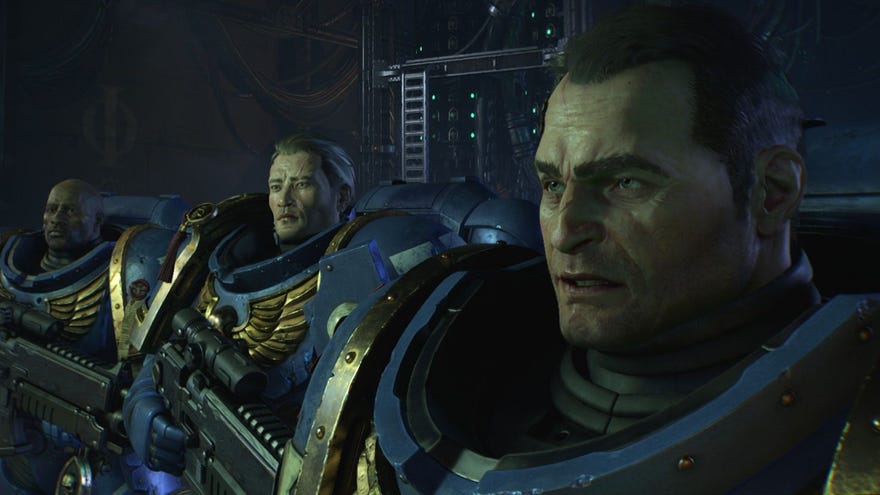Warhammer 40,000: Space Marine 2 review: a devoted sequel of swords and spectacle
Grim lark
It's been 13 years since the first Space Marine came out. While it wasn't outstanding in the grander landscape of gaming, enough Warhammer 40K fans seem to have cherished the escapades of bulky blue boltgunner Demetrian Titus for the action game to merit a sequel a decade later. It left its story on something of a cliffhanger, with said hero being dragged away to face untold tortures by the Inquisition, the most zealous sect of this preternaturally paranoid sci-fi universe. Today, Titus is free again. Free to stomp towards hordes of alien foes, blast them with a plasma incinerator, and shred the stragglers with a chainsaw sword. Space Marine 2 is an often-satisfying scrapper that has me convinced of 40K's merit as a crafting ground for excellent-looking environments and creatures, even if I'm not particularly moved by the bland character of Titus and his fellow Ultramarines.
To provide some context, Titus has been found not guilty after a brief 100-year stint in the torture chambers. We meet him being recruited back into the marines, where he is tasked with leading a squad against endless swarms of tyranids (basically very spiky xenomorphs).
The story takes many cues from the first game. For example, one of your new sidekicks, Gadriel, mirrors the personality of a doublecrossing dirtbag named Leandros from Titus' first adventure (an intentional callback to seed suggestions of mistrust among the squad). And other developments in the plot rhyme with twists of the first game. As a fan you might have two reactions to this kind of story. It may be a comfort blanket of nostalgia, complete with recognisable threads and motifs, or it may be a missed opportunity to take a new direction, and develop Titus or his cohorts in some deeper way.
In other words, this is no grandly moving myth, and our marines are all so similar in their gruff temperament that it's hard for any depth to make itself known. As a story of camaraderie persevering in an environment of overwhelming mistrust, it fulfils its function with a sensuous flogging of the Warhammer 40K lexicon. But even as someone who knows little about this world, this is - in its broad strokes - a predictable tale.
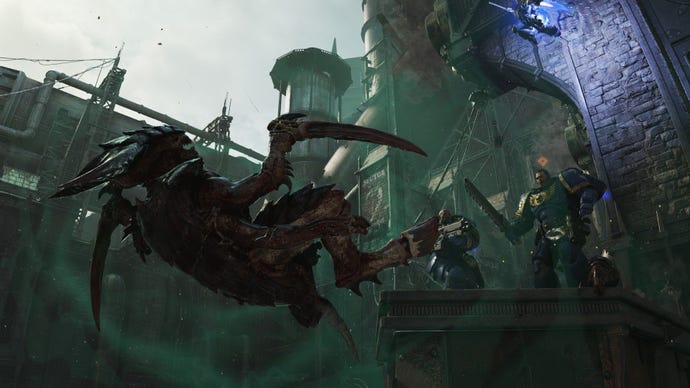
The levels themselves will see you charging into various frays with a mix of ranged and melee combat. It does that health regaining trick made popular by Bloodborne, whereby you can steal back some of your trimmed lost health bar, provided you strike back at an enemy quickly enough. And you have a powerful "rage" ability that also regains your health as you tear through baddies (more on that in a bit).
Eventually fighting becomes a rhythmic loop of thinning out an approaching swarm with your autobolt rifle or heavy bolt pistol, before falling back on the chainsaw, combat knife, or power sword to mop up any creeps that make it through the bullet spray. My favourite guns were the close-quarters Melta rifle, which has a hefty and broad blast, or the chargey railgun zaps of the Las Fusil. But you can also indulge in versatile charged shots with a Plasma Incinerator, flamethrowing Pyreblasters, Stalker rifles with a scope, and boltguns with a grenade launcher attachment. There are quite a few guns that don't feel significantly distinct from one another, but once you find the right bolter for you, it doesn't matter much. They all feel heavy and punchy.
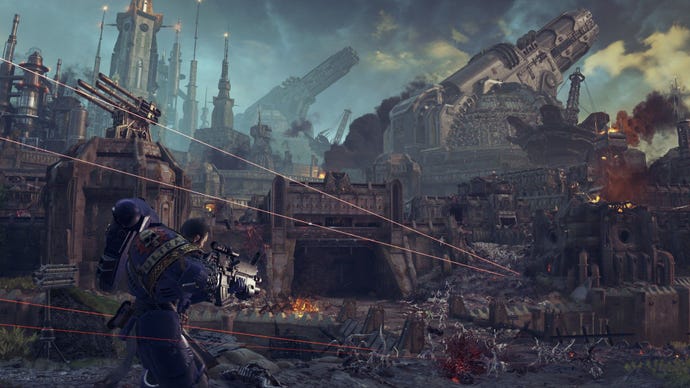
I'm less convinced by the parry system, which works well enough when telegraphed by big blue circles, but feels less precise when parrying basic attacks, or the often overlong windup animations of boss attacks. There's a related problem in that the combat space is often so crowded with enemies that it sometimes becomes difficult to tell what is actually hitting you. Sure, the melee combat feels gory and satisfying, with all its stomps and swipes. But it's also very busy, and I find parry systems work best when I'm given a focus, rather than trying to time a counterattack in the midst of a dogpile. Some boss fights can also become intensely noisy with visual effects that make even seeing the warning reticules very difficult.
The sense of fracas becomes most irksome when fighting airborne enemies. One sequence sees you juggling a flamethrower, melee combat, and a ranged pistol, while dodging quick unblockable attacks from floating psychic tyranids. Late in this scene there is barely room to catch a moment in which to strike, you're so busy dodging attacks.
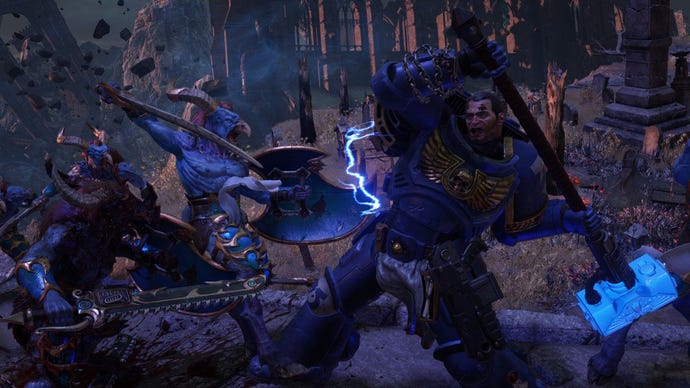
In fairness, this might be the result of that particular level being primarily designed as a co-op multiplayer mission, yet also needing to exist as a single player experience. It's hard to design objectives, spaces, and enemy encounters that will satisfy both requirements. I played alone, but in co-op this same overwhelming sequence might feel badass, as each squad member takes on a different task - one flamethrower dealing with the rats, another soldier battering melee dorks, and a third on lookout for buff-billowing floatbastards. In singleplayer, your AI teammates don't have that level of coordination, and you end up having to multitask in a manner that doesn't always feel smooth or flowing.
Scrambles like this might be a good time to use your special "rage" mode - but it has a punitively long cooldown, and I'm a scrimper by nature. If I know something is rare, I want to save it. This is the old problem of "grenade hoarding" in another guise, and I doubt I'll be the only one who simply forgets that this ability exists. But again, in multiplayer, the other characters have different abilities. And in one mid-game mission each player's ability is replaced by some fluid and fabulous jump jets.

It's stunning how much these jetpacks change the flow of combat. For much of the fighting up to this point, I craved some extra way of either dealing with a swampy crowd or removing myself from a fight (the basic dash is limited - you're very heavy). The jet pack allows for both, giving you a huge stomping airborne attack, and a means of quickly boosting away from your current predicament. Once introduced, it feels like the real way to play Space Marine 2, and yet this merry toy is almost immediately taken away from you after this level, and only reappears once more in a slightly less interesting space. (In the campaign, anyway - I haven't found the time to play through the six side Operations that look like they're intended as the most replayable of the multiplayer meat).
I've been yammering on about the combat and abilities mostly because I want to get the nitty-gritty button-pushing stuff out of the way. Whatever misgivings I have about it, the combat remains a perfectly fine mix of gunblastin', hammer-slammin', and bottle-animated executin'. The jetpacking level got my blood pumping, but what impressed me most about the game is its lusty and rabid devotion to the visual aesthetics, atmosphere, and internal culture of Warhammer 40K.
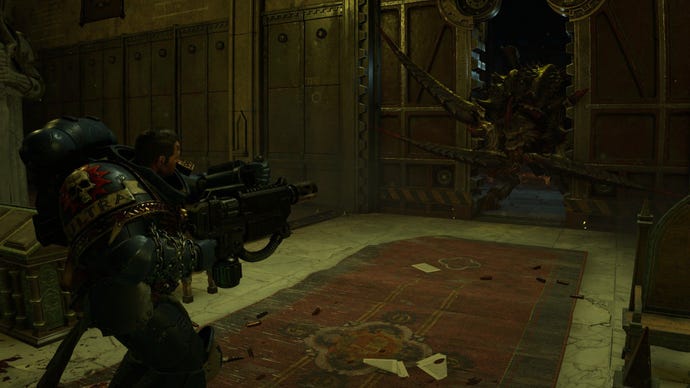
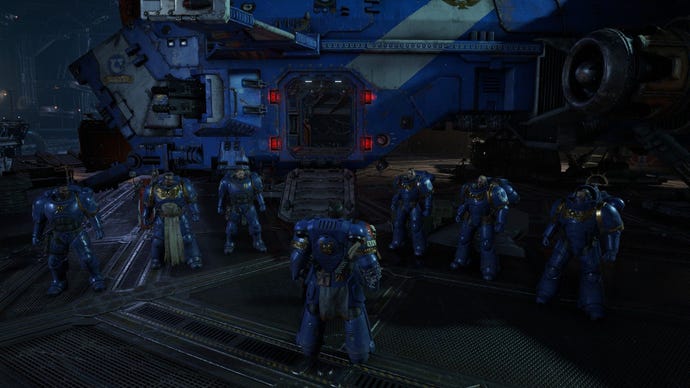
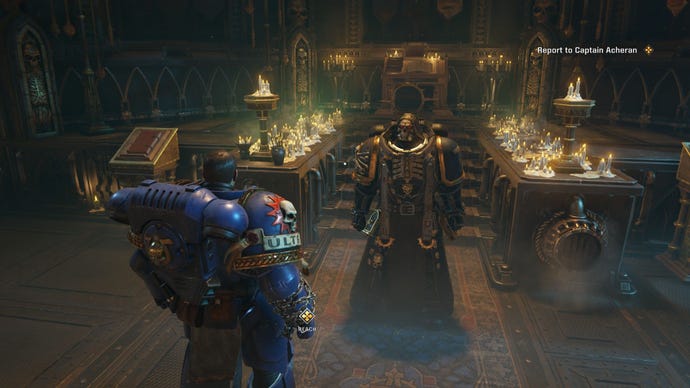

Or my limited understanding of it. I'm not the most Warhammerest of people here at RPS (that would be Nic, who I believe is part Skaven). My favourite artefact of the 40K universe is not a game or novel or tabletop warrior, but the funny video of the snake wot got legs. Until watching multiple lore explainer videos in service of this review, that mechanised reptile was the extent of my 40K knowledge. So let's examine whether Space Marine 2 feels like a good entry point to this world, especially considering the developer's own assertions on this point. "Space Marine 2 is just as captivating and entertaining, whether you’re versed in Warhammer 40,000 lore or not," they say in a press release. "Knowing the complete storyline of the first game is not a requirement."
I always find statements like this difficult to swallow. 40K is such a huge and developed world by now that it's intimidating just to glance at its gleaming pauldrons. I went to see the third Deadpool movie as a Marvel half-hearter and was repeatedly told "you don't need to have seen the previous two movies to enjoy it". Then I was assailed by cameos and TV spin-off characters whose significance I did not comprehend in the slightest. This is the "blorko effect" writ large, and it equally applies here - right down to the late-stage character reveals.
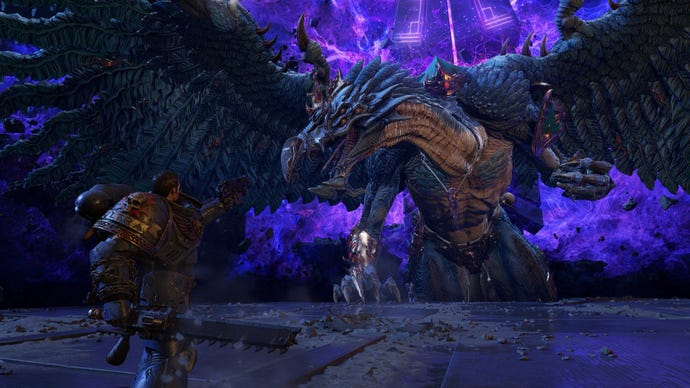
For Space Marine 2, I suspect I would have been adrift without those explainer videos. The feeling of being lost in a pre-existing web of factions and millennia of history definitely grew stronger in later sequences, where I got the sense that some characters were significant in a way I didn't appreciate. Having said this, there is value in diving into the deep end of an existing universe completely cold, and submerging yourself in wild vernacular. Just know that's what you're signing up for.
To sum up my understanding of the universe following this blorko bath, 40K is a realm of over-the-top heft, of taking the unnecessarily brutish route through every problem. And that sense of a hideously comical overengineering goes double for the greebly craft on display when it comes to environmental design, probably my favourite thing about the game. Warhammer 40K is a maximalist melange of decaying Roman empire motifs embedded among sci-fi pipes, railings, metal grates, hanging wires, and rusty girders. All of this liberally daubed with skulls, of course.

Even as someone for whom the aesthetic of tabletop Warhammer never truly gelled (I think giant shoulder pads make everyone look like a knucklehead NFL player), I deeply admire the work that goes into the meticulous recreation of this expansive universe of sad metal and terrifying cyber-cherubs. You look into the sky and see the murmurations of tyranids and think not: "alien scum" but "beautiful alien scum". The grand decor of the Imperium, equal parts ornate and outlandish, is represented in oversized cathedral control rooms, in planet-spanning Sagrada Familias, in supererogatory skyboxes. These spaces are such an amalgamation of skill and effort that I was constantly pausing and dipping into photo mode. As a reviewer, I constantly take screenshots of games I play. On average I might take 30-50 screenshots of a game. For Space Marine 2, I took 235. I pressed the F12 key more times than I activated my rage ability.
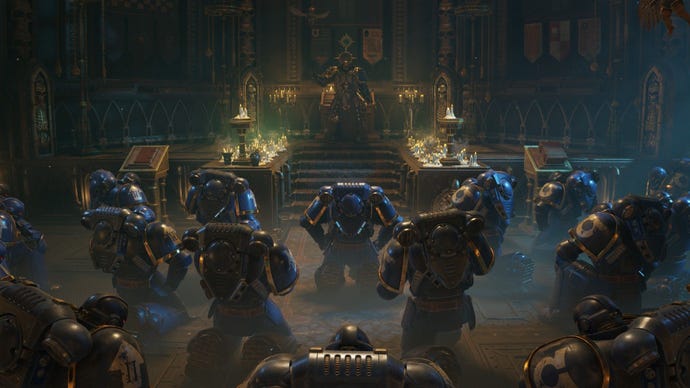
It's not all beauty, mind. I did notice some severe frame drops, and got caught in more than a few freezy moments playing on "High" graphical settings. The sound also periodically bottomed out for some reason. And it was always painfully slow to exit to desktop. Of course, I'm reviewing this in a vacuum, so I don't know how widespread technical difficulties like this might be when it comes to release day. Suffice to say this is PC gaming. As ever, stay frosty.
In short, this is a hulking jaunt through a gauntlet of scum, traitors, filth, and heretics. The social landscape of 40K's galactic hellwar is fuelled primarily by hatred and secondarily by a twisted sense of honour. And it's so overblown it is often Verhoeveningly funny. But within the confines of its own delightful cesspit, the story does its job. It gives us an excuse to see a chaos demon smashing the graves of a thousand unknown souls to pieces. The guns 'n' galumphing likewise serves its weighty purpose. From the perspective of an outsider, this is a well-crafted third-person action game with a story somewhat bloated with lore. From the perspective of a fan, it may be pure ambrosia.
This review is based on a review build of the game provided by the publisher.